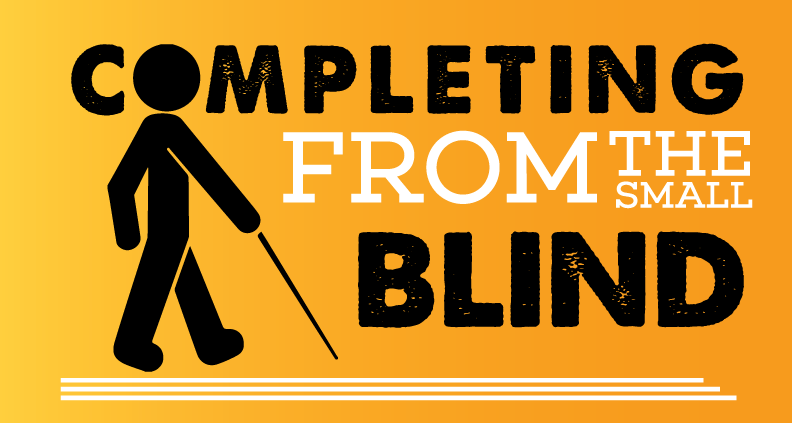Many Hold’em articles and training videos will stress the importance of paying attention to the action at the table, even when you are not involved in the hand. Getting clues to your opponents’ playing styles can often help you maximize EV in future hands against them. Here is a concrete example of a hand I recently observed at my table, and how those observations suggested strategies to play against each of the two opponents involved.
The setting was a $1-$2 table at the Cleveland Horseshoe on a Friday night. As with most $1-2 live tables, the skill level didn’t appear to be very high – way too much limping with junky hands and trying to hit hidden monsters. In this particular hand, I folded my cards from under the gun, and action folded all the way around the table to the small blind. He completed by adding a white chip and the big blind rapped the table, and we were off to a heads up pot.
An article from Red Chip Poker about How To Complete From The Small Blind
The flop came out J 9 5, all different suits. The small blind bet $5 into the $4 pot and the big blind quickly called. Because this is a limped pot, ranges are still very wide and either of these players could really be holding any two cards. But we do know that the big blind called this flop bet with something. That something can be a pair, a bigger straight draw like Queen-Ten, or perhaps a gutshot draw like 67 or 78. There were no flushes to think about, at least not yet. The small blind is a little harder to put on a hand, as he is the aggressor at the moment, he could have many of the same hands as above, or no hand at all and is just attempting to win the pot.
The turn brought an 8 and a backdoor flush draw. Once again, the small blind lead out, this time for $10, and was quickly called again by the big blind. Queen-Ten and 67 just became straights. My guess is that the big blind would raise a hand that strong, or even a two-pair hand, but he was just calling again. This led me to believe his hand was more likely to be a pair, and of course top pairs are more likely than lower ones. If he did happen to have a jack, his second card could be literally anything.
The river paired the bottom card on the board, a five, so the final board was J9585, with no flush. Once again, the small blind lead out into the pot, this time for $20, and without much thought, the big blind raised the bet to $55. The small blind considered his action and then called the bet, flipping over his cards and showing 6-5 offsuit. The big blind flipped over A-5 suited. They both ended up with trips, with the big blind winning the kicker battle.
J♥ 9♣ 5♠ 8♠ 5♥
After watching this hand, I replayed the action in my mind to try and see what mistakes each player might have made. I don’t think either player played this hand particularly well. The small blind limped into a pot with six-five offsuit, an extremely weak hand where he will be first to act on all future streets. Either folding this junk or raising in an attempt to win the blinds would have both been better options. Post flop, one could argue that at least he tried to win the pot by staying aggressive with bottom pair – his bets serve the purpose of value bets against some of the straight draws and they pick up dead money against unpaired higher cards. Once he hits trip five on the river, he pretty much has to pay off this raise, I guess, thinking that plenty of worse hands (like two pair) might make the same raise. But he could have avoided losing a big pot by opting to never play a hand so weak – he ended up hitting a second-best hand just strong enough to give away chips.
Of the two players, the big blind played this hand much more poorly. He checked preflop with a suited ace – a raise would have probably received plenty of value against a worse range, or at the very least picked up dead money against hands with some equity against them. After hitting bottom pair on the flop, he calls two decent-sized bets (relative to the size of the pot) because…. why? Is he attempting to hit an ace for two pair or a 5 for trips? (we know that won’t happen often enough to warrant calls to the river). Or does he feel like he’s somehow ahead after two bets?
Based on this one showdown, we can start to draw conclusions about the two players. The small blind has fishy tendencies but appears to play aggressively post flop. We can call him an aggressive-fish, or a-fish for short. The big blind appears pretty clueless and would probably best be described as a passive fish (p-fish for short), or a calling station.
Here is a free video/article about Taking Creative Lines Against Fish
Once we have categorized our opponents, we can start to come up with strategies for beating them. Calling stations are really easy to beat – we just need to hit a hand like top pair and start betting as large as we think the villain will call. We know he’ll call with pairs all the way down to bottom pair, so just about any top pair rates to be well ahead of his calling range. If we’re lucky enough to hit top pair against him, the recipe is value, value, value.
The small blind is a bit tougher to formulate a strategy against. He appears to play aggressive post flop, but can do so with a very weak range. One strategy might be to raise his continuation bets – in theory, his weak range could not tolerate a raise (although we don’t fully know if this player would realize that, what if we raise and he calls with bottom pair, trying to hit trips?). We could also float the flop bet and represent scary draws on future streets if they come in.
There is potentially a wealth of information available in every Hold’em hand. Every showdown you get to see can tell you how an opponent plays, and can give you a recipe to beat them. All you have to do is keep paying attention, even after you have folded.


